- Scroll bar under destination image to the right to see more locations.
- Mouseover image for info.
- Click on an image to travel.
- A throttle will appear. Click the throttle to engage engines.
- Look up! Your journey will start in the forward window.
| Destinations | Location Data | 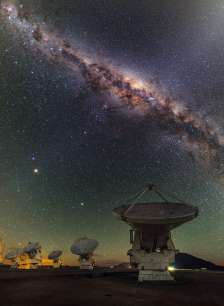 |
|
|
ALMA antennas and the central regions of the Milky Way: 6,200 light years. In the lower left Mars is seen. Saturn is a bit higher in the sky towards the centre of the image. - ESO |
|
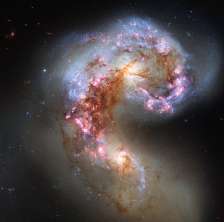 |
Antennae Galaxies - also known as NGC 4038 and NGC 4039 These colliding galaxies are locked in a deadly embrace. This clash is so violent that stars have been ripped from their host galaxies to form a streaming arc between the two. In wide-field images of the pair the reason for their name becomes clear - far-flung stars and streamers of gas stretch out into space, creating long tidal tails reminiscent of antennae. |
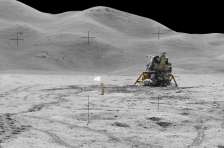 |
Apollo 15 Landing Zone: Moon - the eastern edge of Mare Imbrium, known as Palus Putredinis> With the aid of the lunar roving vehicle, astronauts Dave Scott and Jim Irwin were able to examine the Apennine Front at Hadley Delta, the eastern rim of Hadley Rille, and two prominent groups of craters on the mare surface. |
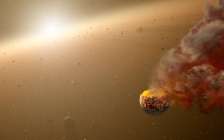 |
Building Planets Through Collisions - NGC 2547-ID8: 1,200 light years - Planets form from epic collisions between asteroids and even bigger proto-planets. This artist's conception shows one such smash-up, the evidence for which was collected by NASA's Spitzer Space Telescope. - NASA |
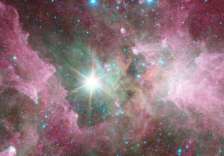 |
Clouds of Eta Carinae: 7,500 light years - 100 times the mass, and a Million times brighter than our sun. One of the most massive stars in the galaxy. So powerful, it is destroying the surrounding nebula. Some astronomers think it could explode as a supernova in the not-too-distant future. Explore with caution! |
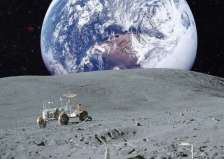 |
Lunar Earthrise Apollo Rover |
 |
Waterworld Moon Milford on a rogue extra galactic, solar system, 130,000 light years outside the M66 Galaxy in Leo Triplet: 35 Million light years - photo montage |
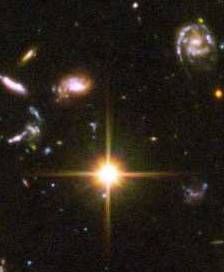 |
Hubble Ultra Deep Field - North, in Fornax - about 45 Billion light years distant, due to spatial expansion. Age of light is 13.5 Billion years. Galaxies, galaxies everywhere - as far as NASA's Hubble Space Telescope can see. This view of nearly 10,000 galaxies is the deepest visible-light image of the cosmos. Called the Hubble Ultra Deep Field, this galaxy-studded view represents a "deep" core sample of the universe, cutting across Billions of light-years. - Hubble |
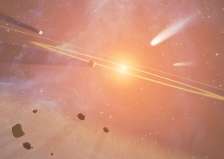 |
Epsilon Eridani Double the Rubble: 10.47 light years - This artist's conception shows the closest known planetary system to our own, called Epsilon Eridani. Observations from NASA's Spitzer Space Telescope show that the system hosts two asteroid belts, in addition to previously identified candidate planets and an outer comet ring. Epsilon Eridani is visible in the night skies with the naked eye. - JPL |
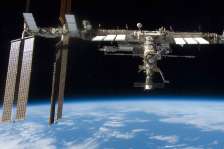 |
International Space Station in orbit - The International Space Station is a unique place, a convergence of science, technology and human innovation that demonstrates new technologies and makes research breakthroughs not possible on Earth. The international crew of six people live and work, while traveling at a speed of five miles per second, orbiting Earth every 90 minutes. - ISS NASA |
 |
International Space Station Wide View - A montage of multiple photographs, made for the Starship Simulator. ISS NASA |
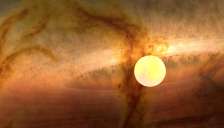 |
HD 141943 with planetary disk in Ophiuchus. Loops of dust rise from Planetary Disks - Magnetic loops carry gas and dust above disks of planet-forming material circling stars, as shown in this artist's conception. These loops give off extra heat, which NASA's Spitzer Space Telescope detects as infrared light. The colors in this illustration show what an alien observer with eyes sensitive to both visible light and infrared wavelengths might see. - JPL NASA |
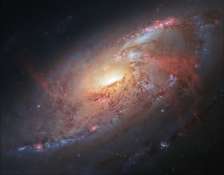 |
M106 Galaxy: 23.7 Million Light Years - At M106's heart is a super massive black hole actively gobbling up material heating has and emitying powerful radiation. Instead of two spiral arms, it appears to have four, two are made of hot gases and may be caused by the black hole. Travel warning to M106. Don't approach closer than 2500 light years of M106's center. - ESA |
 |
Mars Lander Husband Hill Panorama - The silica-rich soil neighbors a low plateau called Home Plate, which was Spirit's main destination after the historic climb up Husband Hill. - JPL NASA |
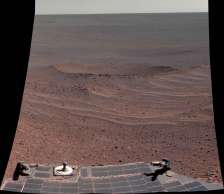 |
Mars Lander Hatch View - Humanity's first real overland expedition across another planet. Spirit explored just as we would have, seeing a distant hill, climbing it, and showing us the vista from the summit. - JPL NASA |
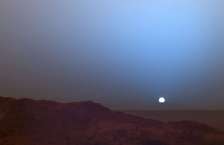 |
Martian Sunset Blue sky - Opportunity Nov. 2010 - On Earth, blue light is scattered all over by air molecules. Mars has less than 1 percent of our atmosphere. The blue light does not scattered which gives the blue sunset. Hidden extra! Try going to this destination and looking deep underground for a new Martian home. |
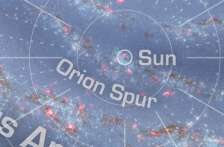 |
Milky way annotated - very large map - Find your way around the Galaxy with this overhead view of all the arms. Like early explorers mapping the continents of our globe, astronomers are charting our galaxy, the Milky Way, it's elegant spiral structure is dominated by two major and a few smaller arms wrapping off the ends of a central bar of stars. Our sun lies near a small, partial arm called the Orion Arm, or Orion Spur, located between the inward, Sagittarius and spinward, Perseus arms. Most all the stars we see at night are within the Orion Spur. |
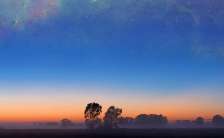 |
Milky Way over Kansas - montage - Kansas summer evening. credit |
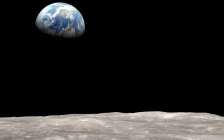 |
Moon Bumps from Earth Tide Lunar Orbit |
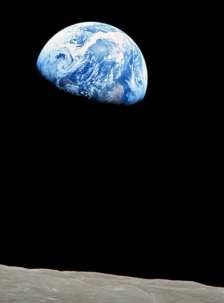 |
Earthrise from Lunar orbit from |
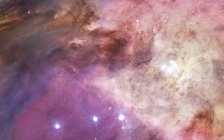 |
The Orion Nebula: 1,344 light years
"In this bowl of stars we see the entire formation history of Orion printed into the features of the nebula: arcs, blobs, pillars, and rings of dust that resemble cigar smoke... Each one tells a story of stellar winds from young stars that impact the environment and the material ejected from other stars. This appears to be a typical star-forming environment. Our sun may have been born 4.5 billion years ago in a cloud like this one." - NASA ESA M. Robberto Used by permission |
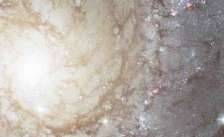 |
Pinwheel Galaxy: 20.9 Million light years - taken in visible and infrared light come together in a colorful depiction of many of the galaxy's features. Bright blue areas of star formation pepper the spiral arms, while ruddy dust lanes follow the spiral structure into a yellowish central nucleus of older-population stars. |
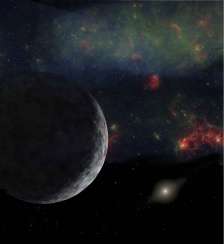 |
Dwarf Planet Eris 136199: 6 to 9 Billion miles - View from Eris's moon Dysnomia and a view of the Sun. Eris is 44 degrees above the ecliptic. The closest approach to Earth will not be until the year 2235, when it will be just within the mid distance range of Pluto. - Nat Geo |
 |
Palos Verdes Launch Hill Lighthouse overlook launch pad - Southern California |
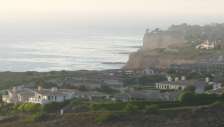 |
Palos Verdes Launch Hill Northwest View - Southern California |
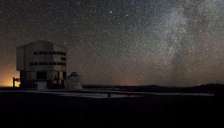 |
Chile Paranal Platform ESO - Milky Way Panorama from the Southern Skies - The Milky Way arches across this rare 360-degree panorama of the night sky above the Paranal platform, home of ESO's Very Large Telescope. The image was made from 37 individual frames with a total exposure time of about 30 minutes, taken in the early morning hours. The Moon is just rising and the zodiacal light shines above it, while the Milky Way stretches across the sky opposite the observatory. - ESO |
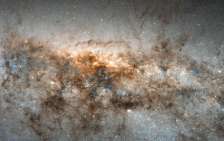 |
Whale Galaxy - The belly of the cosmic whale: 30 Million light years - NASA/ESA Hubble Space Telescope has peered deep into NGC 4631, better known as the Whale Galaxy. Here, a profusion of starbirth lights up the galactic centre, revealing bands of dark material between us and the starburst. The galaxy's activity tapers off in its outer regions where there are fewer stars and less dust, but these are still punctuated by pockets of star formation. |
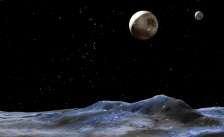 |
Pluto and Charon view from Hydra: 2.7 to 4.5 Billion miles - The artist's concept above shows the Pluto system from the surface of one of the smaller moons. Pluto is the large disk at center, right. Charon, the system's largest confirmed moon, is the smaller disk to the right of Pluto. - NASA |
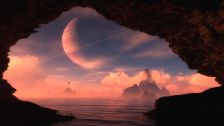 |
Caves of Titan Saturn System: 750 to 940 Million miles - A montage of multiple photographs, made for the Starship Simulator. Shangri-La is the large dark area in sunlight. The western edge is the landing spot of the Huygens probe. - The left side Caves of Titan and Saturn image is from the artist dblasphemy |
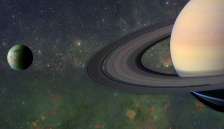 |
Titan and Saturn 750 to 940 Million miles - NASA |
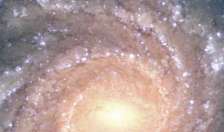 |
Spiral galaxy NGC 1232: 100 Million light years - located 20 degrees south of the celestial equator, in the constellation Eridanus (The River). Central area contains older reddish stars and the spiral arms have younger, blue stars and many star-forming regions. - ESO |
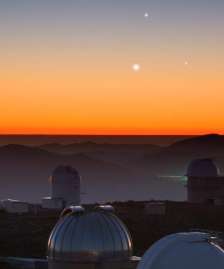 |
Chile, La Silla - Three planets dance over horizon, Jupiter, Venus and Mercury - this event is also known as a triple near-conjunction. The ESO photo ambassador, Yuri Beletsky, who had the chance to spot this spectacular view from ESO's La Silla Observatory in northern Chile on Sunday 26 May. Above the round domes of the telescopes, three of the planets in our Solar System - Jupiter (top), Venus (lower left), and Mercury (lower right) - were revealed after sunset, engaged in their cosmic dance. - ESO |
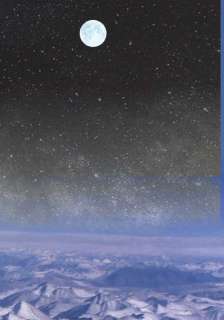 |
Blue Moon over Tibet |
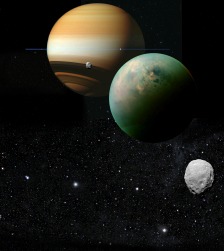 |
Epimetheus Titan Janus Saturn: 750 to 940 Million miles - A montage of multiple photographs, made for the Starship Simulator. |
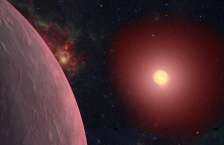 |
MOA-2007-BLG-192LB Rocky Planet: 3000 light years - Artist's conception of the newly discovered planet orbiting a brown dwarf "star" with a mass of only 6 percent of that of the Sun. Theory suggests that the 3-Earth-mass planet is made primarily of rock and ice. Observational and theoretical studies of brown dwarfs reveal that they have a magenta color due to absorption by elements such as sodium and potassium in their atmospheres. - A montage for the Starship Simulator of multiple photographs. ESO |
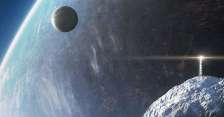 |
Nu2 Lupi e - Hogolyo (a solar twin system). Large .98 Mass Earth planet, Folda and inner moon, Labdarugas. View from the habitable Moon Hogolyo in the Nuar-2 district and Lighthouse Jelado-3. A hiking EVA team is currently on the lower center ridge. Scan down and zoom in to see them. - Unknown 3D Artist |
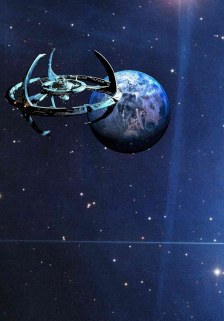 |
The Pleiades Star Cluster (from the Seven Sisters - Greek Mythology) - Deep Space 9 and Planet Meridian - currently in phase with local space. 444 Light years. The Cluster core is about 8 light years radius with tidal bulge of 43 lights years. There are about 1000 large confirmed stars, including many binary stars. It is dominated by young, hot blue stars and some brown dwarfs for about numerically 25% of the stars but only totaling less than 2% of the total mass. The total mass of the cluster is estimated at 800 solar masses. Major stars of the cluster are: Alcyone, Atlas, Elextra, Maia, Merope, Taygeta, Pleione, Celaeno, Sterope / Asterope binary, 18 Tauri. HD 23514 star has extensive hot dust particles and probably planetary formation. The age of the cluster is estimated at 115 million years and therefore expected to have no indigenous life on any planets. |
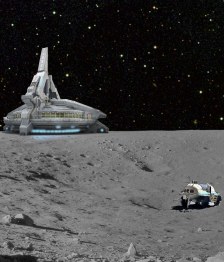 |
Izanagi Ridge - Lakota Base - Rhea Moon - Saturn System - 720 to 950 million miles. Atmosphere: low pressure O2 (70%), C02 (30%) but 5 trillion times less dense than Earth's Oxygen at sea level. Temperature should be -174 C but may warm further to about - 120 degrees in direct Sun. There are debris rings of boulders orbiting the moon. Diameter is only 949 miles, closet approach to Saturn is 327,177 miles in an almost perfect circular orbit every 4.5 days. The orbit appears to be synchronous, which means Saturn will always be above a specific place in the sky from the same point on the moon. - Rhea - Saturn's Dirty Snowball Moon with an atmosphere of oxygen |
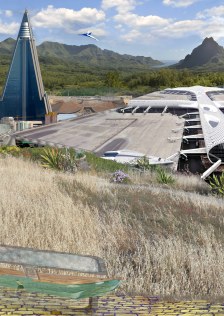 |
Kimolana - Māmaka'Upu Spaceport
A well known resort location in Tau+ near the Sigma border past on the inner edge of the Orion Spur. Arrival of local system transport flight and docked is a fusion drive luxury transport. This planet offers resort activities, lake and ocean views, cliff houses, extensive local parks with hiking and views in between a tropical island location. Warp drive is needed for transport to this system. Average seaside temperatures is 83°F Earthlike Atmosphere O2 (21%), N (77%) CO2 (0.09%) Day=32 hours, Year=124.4 days Gravity is .93 Earth K5 star has 0.6 solar mass |
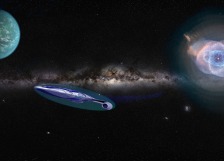 |
Cat's-Eye Planetary Nebula in Draco - NGC-6543: Orion Spur-Kicker
The Spur-Kicker has advanced Transwarp cabilities exceeded 286,000 times light speed allowing incredible short transit times even to the edge of the Orion Spur, hence the name. Here is an angle view toward the galactic center showing Sagittarius Galactic Arm and Neue Phaeton Exoplanet orbiting a Binary Star accretion disk within the Cat's Eye Nebula. Flight within the nebulae is restricted and dangerous. Space inside the nebulae has scattered density, extremely high velocity and is at 7000 to 9000° Kelvin. This is the expected reminant for our Sun's own blow-out event in about 5 Billion years. |
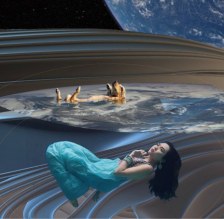 |
Earth Orbit
|
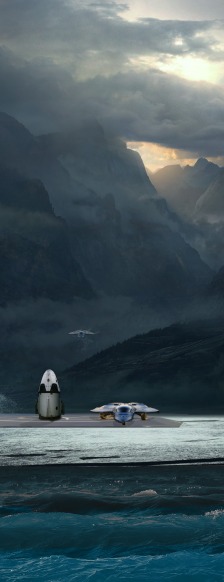 |
Paradise Scorpii 62c Paradise unusual orbit varies it's distance from Scorpii 62 as much as 0.2 AU which gives it extreme seasonal temperature swings: -10 to 28° Celsius and 66 day high tides cycles. in excess of 20 Meters. The orbit of Paradise is much closer to it's Sun, but also similar to the orbit to 617 Patroclus, a Jupiter Trojan, in our Solar System
|
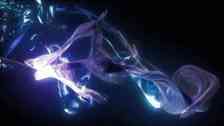 |
Transitions animated gifs were created by: Jason |